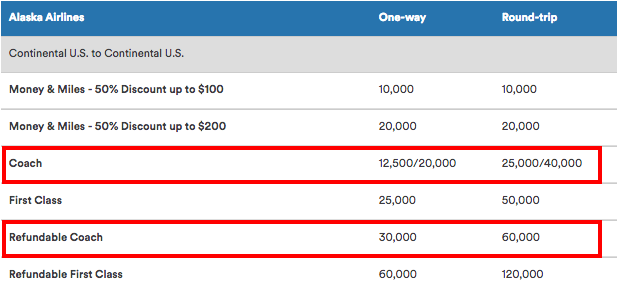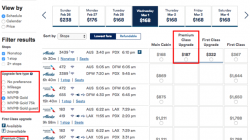I just wrote last week about some changes to how Alaska Airlines displays upgrade availability on its website, and now today there’s news that it’s also changed the qualification rules for most first class upgrades. There are three basic changes:
- One less eligible fare class for MVP and MVP Gold upgrades
- Complimentary upgrades will be available on all economy class award tickets
- The purchased fare class will be part of the hierarchy for complimentary upgrades
Overall, these are not major changes, and they will not take effect until December 5. However, the last one in particular represents a fundamental change in the way that Alaska Airlines operates. I’ll discuss it first and work backwards. (As far as I can tell, there are no changes to the rules for Gold Guest Upgrades.)
New Upgrade Hierarchy
Previously, Alaska Airlines only took into consideration two criteria when clearing complimentary upgrades to first class: elite status and time of request. Typically the time of request is the time of booking, so really as long as you booked your ticket early you had a very good chance of getting an upgrade. Someone with a cheap G fare who books before an expensive Y fare would get the upgrade first.
Now, fare class matters. This makes sense and is how many other carriers operate. That person purchasing the last-minute fare probably represents more value to the airline. It also helps offset the problem faced by people who change their tickets.
The order of upgrades (from first to last): Y, Z, S, B, M, H, Q, L, V, N, K, G, T, R, W.
Remember that Alaska has a very generous change policy for MVP Gold and 75K members, who can change their ticket at any time without penalty (other customers can change up to 60 days before departure). But a ticket change also changes the time of upgrade request, which would move you to the bottom of the list even if you had purchased an expensive fare from the start. Ranking customers by fare allows you to keep your priority even when plans change.
This change will take effect for flights purchased on or after December 5, 2016.
Upgrades on Award Tickets
The second major change is that award tickets originally booked in economy class will become eligible for first class upgrades. There are two elements to this:
Refundable economy class awards (which can be cancelled or changed without penalty) are eligible for an instant upgrade to first class. That means if for some reason there is a first class upgrade available — but no first class award — you can confirm your upgrade immediately.
Second, non-refundable economy class awards (which are cheaper but have restrictions) are eligible for complimentary upgrades to first class. These are processed closer to departure, in the same queue as the complimentary upgrades just discussed above.
Note that refundable awards are also known as Z class. These cost 30,000 miles one way for most U.S. domestic tickets. Non-refundable awards have two prices, since the slightly more expensive ones have more availability. The more expensive of the two is a N fare (20,000 miles one way), and the absolute cheapest is a W fare (12,500 miles one way).

A very important point is that not all award tickets are processed last. They are actually spaced out in the fare hierarchy. I’ve copied the same hierarchy above and highlighted the award fare classes.
The order of upgrades (from first to last): Y, Z, S, B, M, H, Q, L, V, N, K, G, T, R, W.
So actually, someone who buys a mid-priced award ticket for 20,000 miles one way could get upgraded before some passengers who buy a paid ticket in K, G, T, or R, and a refundable coach award will be second only to full Y fare paid tickets.
Note that award tickets will become eligible for complimentary upgrades on December 5, 2016, regardless of when you booked the award.
Instant Upgrades on Expensive Fares
Finally, some fares qualify for instant upgrades. I already mentioned refundable economy award tickets as one example. But elite members have long been able to upgrade many other fare classes. This is a great benefit (Alaska has more eligible fares than most carriers) but didn’t do much to differentiate elite tiers. Why? MVP Gold and 75K members, for example, had the same eligible fares. At least in this respect there was no added benefit to being a 75K member.
Some of the eligible fares are being removed from the MVP and the MVP Gold tiers to better differentiate the benefits of each status. Here are the current and new eligible fares that can be upgraded immediately at the time of booking.

The key points here are the loss of upgrades for B fares if you’re an MVP member and the loss of upgrades for H fares if you’re an MVP Gold member. MVP Gold 75K members will see no changes. Again, these rules will go into effect for flights booked on or after December 5, 2016.
I’m not terribly concerned about this new rule. Although it’s always sad to see some benefits removed, I think in many cases the people who took advantage of these upgrades were already buying expensive tickets because that’s what was left. In my case it was not uncommon to see expensive fares to Hawaii in the winter, always in M or H, and so that’s what I would buy. I would gladly have bought a G fare if it was there. But it’s true there are some people who viewed this as a cheap way to “buy” a first class fare, by purchasing a slightly more expensive coach ticket and upgrading it immediately.
Summary
There are a lot of changes here to Alaska’s upgrade policies, affecting complimentary upgrades, instant upgrades, and award travel. In aggregate I believe they are positive for the customer. In particular I think it is great that award tickets will be upgradeable and that they won’t all be lumped at the end like they are at some airlines. If you redeem more miles for an expensive award, you deserve to get higher priority. I’m not thrilled that some fares will become ineligible for instant upgrades, but it does do a better job of differentiating the elite tiers. Finally, I think that using fare class as one element for determining upgrade hierarchy better rewards the customers who deliver value to the airline, and it is consistent with the practices of most other carriers.


